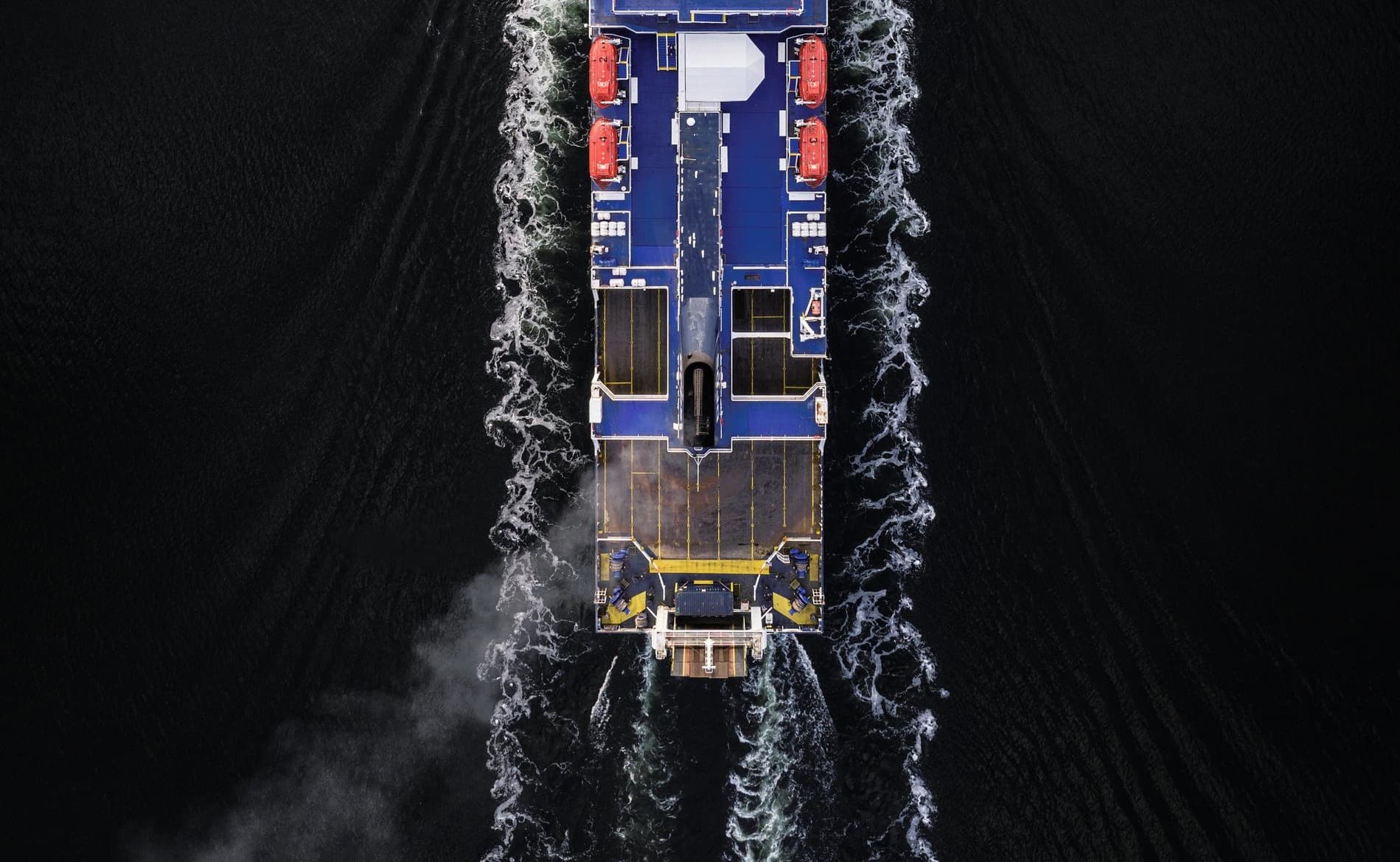
Decarbonisation solutions
You can now reduce your CO2e Scope 3 emissions and receive a certificate for your climate action reporting with DFDS Decarbonised Solutions.
Integrated solutions
Logistics SolutionsSupply Chain SolutionsThird Party Logistics (3PL)Fourth Party Logistics (4PL)WarehousingConnectivity SolutionsProject CargoCustoms ClearanceDecarbonised SolutionsContract Logistics
With the 2030 Climate Target Plan, the Commission raised the EU's ambition to reduce greenhouse gas emissions to at least 55% below 1990 levels by 2030. While maritime transport plays an essential role in the EU economy and is one of the most energy-efficient modes of transport, it represents 3 to 4% of the total CO2 emissions for the EU. To significantly reduce greenhouse gas (GHG) emissions caused by international shipping, the EU implemented a number of legislative regulations.
What does the ETS mean for shipping companies? Since 2024, shipping companies operating between ports in the EU/EEA have paid annual EU Allowances (EUAs) for greenhouse gases (GHG) emissions. Emissions are reported and verified by the EU monitoring, which over time will cover more emission types, ship types and sizes.
What is the aim of adding shipping to the EU Emissions Trading System? The Emissions Trading System (ETS) aims to create a financial incentive for shipping companies to reduce their GHG Emissions in accordance with EU’s aim of being climate neutral by 2050 (e.g. running an economy with net-zero greenhouse gas emissions).

ETS will continue to cover commercial ships transporting cargo or passengers* above 5,000 gross tonnage (GT).
ETS will still cover 100% of emissions on voyages between EU/EEA ports and 50% of emissions on voyages between a EU/EEA port and a non-EU/EEA port.
*ETS cost will be split between freight & passenger

The costs of compliance with ETS are significant and will impact our operations, costs, and contractual agreements.
As with past regulations, we will introduce a surcharge to the market, to cover the increased costs implemented by the EU. Customers will therefore be subject to a standalone surcharge from January 1st, 2024.
What’s new in 2025? In 2025, ETS will cover 70% of shipping emissions and incorporate FuelEU Maritime compliance costs.
ETS charges will continue to be adjusted monthly, reflecting forecasted freight volumes and emissions for each route.

The FuelEU Maritime regulation (FEUM) is a complementary regulation to the EU ETS that aims to reduce greenhouse gas emissions in the shipping industry by setting maximum limits on the yearly greenhouse gas intensity of the energy used by a ship.
The limits will increase over time, from reducing greenhouse gas intensity by 2% in 2025, to as much as 80% by 2050. This is meant to stimulate and reflect the expected developments in technology and the increased production of renewable and low-carbon fuels. The new rules also introduce an additional zero-emission requirement for ships at berth, mandating the use of onshore power supply (OPS) or alternative zero-emission technologies in ports.
Like ETS, FEUM will apply to vessels above 5,000 gross tonnage that call at EEA ports, no matter what flag they fly (EU/non-EU). The FEUM will cover:
100% of the energy used from ships calling at an EU/EEA port for voyages within the EU/EEA (intra-EU)
50% of the energy used from voyages to or from EU ports (extra-EU/EEA)
100% of the energy used when ships are at berth in EU/EEA ports.
Under FEUM, ships will be allowed to pool their compliance balance with one or more other ships. In this scenario, it will be the pool as a whole that must meet the greenhouse gas intensity limits on average – rather than each individual ship.
Read more here.
With either direct or indirect insetting, our customers can achieve real CO2e reductions within own supply chain. Our carbon emission reductions are generated in our own transport network, for example by using low-emission fuels in our vessels.
DFDS can offer up to 86% CO2e reductions WtW (thanks to ISCC/RSB certified biofuel) compared to heavy fuel oil (HFO)
DFDS will waive all or part of the ETS cost related to the seaborn transport, based on the percentage of emission reductions achieved through insetting.
The emissions reduction process is reviewed by an independent external party.
We are constantly optimising our vessel operations, including adjusting speed, streamlining schedules, reducing turnaround times at terminals, and implementing technical upgrades. In 2024, we achieved a 5% reduction in tank-to-wake carbon dioxide emissions across our freight shipping network. Our Vessels of Tomorrow programme is a key part of our new strategy. By 2030, we aim to have two methanol-powered, two electric, and two ammonia-fuelled vessels in operation.
As of 1 January 2024, shipping companies will monitor emissions in accordance with the revised monitoring plan that should be assessed by verifiers and approved by the administering authority.
Once per year, shipping companies must submit an emissions report for each of the ships under their responsibility, as well an emissions report at company level. All ship-level and company-level emissions reports must be verified by an accredited verifier by 31 March of the following year.
Once aggregated emissions data at company level have been verified and submitted to the administering authority, shipping companies must surrender the equivalent number of allowances in the Union Registry by 30 September of that year.
No. Shipping companies will need to surrender (use) EU allowances (EUA) corresponding to the amount of aggregated emissions data at the company level to be reported under the EU ETS Directive. Carbon credits or certificates cannot be used for EU ETS compliance purposes.
Shipping companies covered by the EU ETS are required to have an approved monitoring plan for monitoring and reporting annual emissions. Every year, companies must submit an emissions report for each of the ships under their responsibility, as well as an emissions report at the company level (aggregating the ship data to be reported for ETS purposes).
The data for a given year must be verified by shipping companies covered by the EU ETS. Shipping companies are also required to have an approved monitoring plan for monitoring and reporting annual emissions. Every year, companies must submit an emissions report for each of the ship under their responsibility, as well an emissions report at company level (aggregating the ship data to be reported for ETS purposes). The data for a given year must be verified by an accredited verifier by 31 March of the following year (or by 28 February if so requested by the administering authority). Once verified, companies must surrender (use) the equivalent number of allowances by 30 September of that year.
Shipping companies are subject to obligations under the MRV Regulation since 2018. Data must be reported through THETIS-MRV, a platform operated by the European Maritime Safety Agency (EMSA) which enables, among other benefits, the publication of reliable data on ships’ emissions.
The revised EU ETS provides dedicated support to accelerate the decarbonisation of the maritime sector through the Innovation Fund. The Innovation Fund could support a wide diversity of projects and innovative solutions in the maritime sector, across the whole sector, and at scale, including in relation to the production and uptake of renewable and low-carbon fuels.
Besides the Innovation Fund, all auction revenues attributed to EU Member States have to be used for climate-related purposes; and the list of these purposes has been expanded to explicitly cover measures to decarbonise the maritime sector. The list also includes the financing of climate action in vulnerable third countries, including adaptation to the impacts of climate change.
Our ETS model is based on a charge per lane metre as we are selling our capacity on the basis of lane metres. The impact on our consumption and thereby our emission from weight is insignificant. Whether the last trailer on a full vessel is empty or loaded with max weight capacity will not change the bunker consumption at a level that we can even measure.
DFDS decides to follow the industry standard for RoRo activities which currently is reflecting the charge per lane metre.